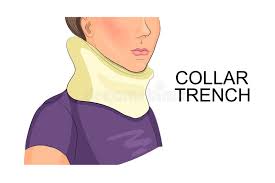| Secondary outcomes include:
a) Patient or clinician – reported skin damage (bruise, abrasion or wound) due to the collar
b) Patient-reported ease of eating and drinking
c) Patient or clinician reported episodes of aspiration
d) Clinician-documented short term adverse neurological events defined as tingling, numbness or weakness in arms in a nerve root distribution
e) Clinician-reported rate of non-compliance (removal or loosening of collar such that it is ineffective)
f) Clinician-reported rate of agitation
g) Incidence of cervical spine fracture or spinal cord injury
h) Presence of a clinically important cervical spine injury |

